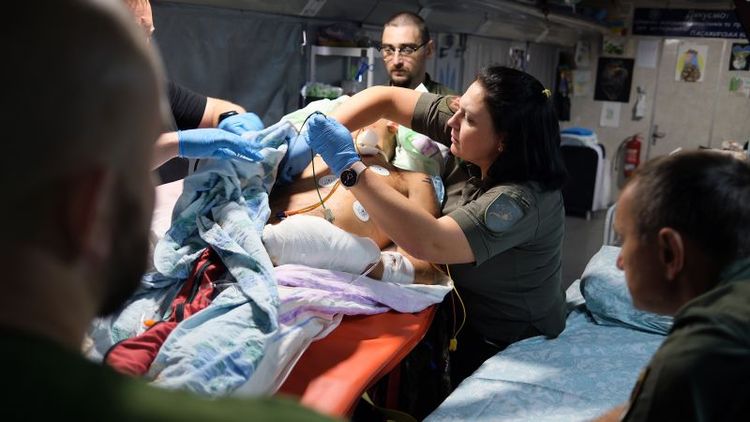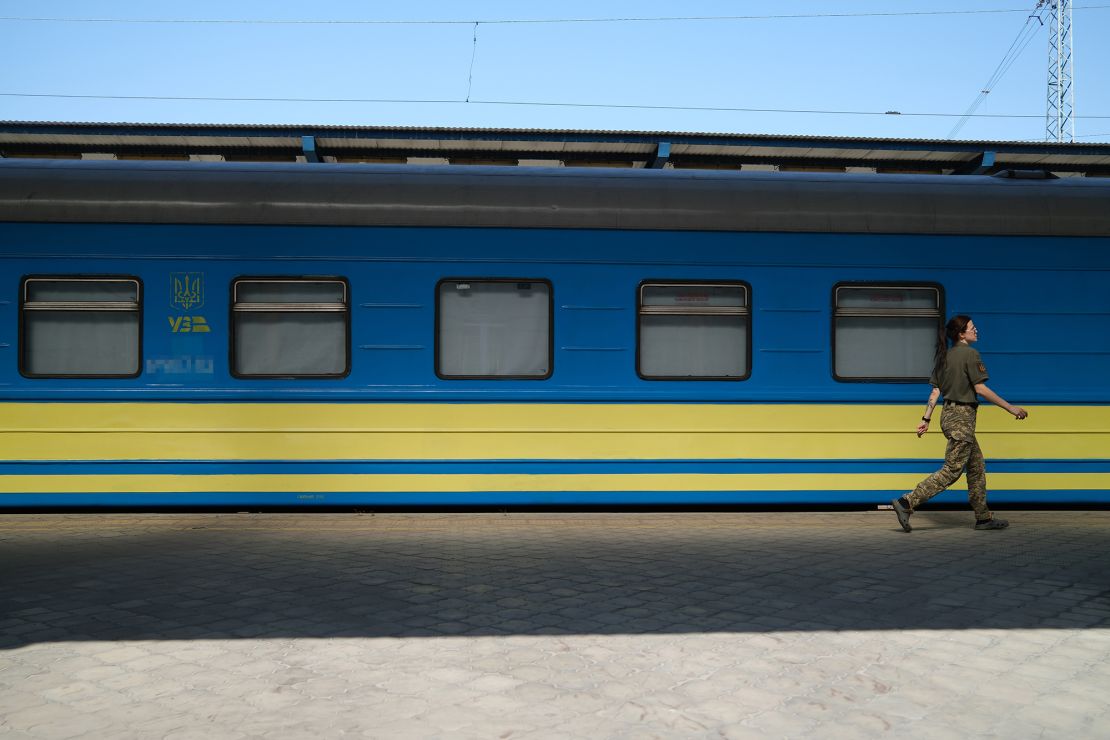On board the lifesaving hospital train bringing Ukraine’s wounded soldiers to safety | CNN

Olga is bustling through the intensive care unit, frequently monitoring her patients' oxygen levels, fine-tuning their medications, and recording their vital signs. She moves quickly, but even during her most hectic moments, the nurse anesthetist takes the time to rearrange a pillow or blanket, ensuring that the wounded soldiers she looks after are as comfortable as they can be amidst the ongoing shaking and noise.

As a sergeant in the Ukrainian army, she is caring for some of the most critically ill patients. It's a hectic role, and she's managing it all while on a fast-moving train.
CNN was granted special access to a medical evacuation train utilized by the Ukrainian military to move injured soldiers from areas close to the frontlines to hospitals throughout the country. This mobile medical unit—one of several traveling across Ukraine—has become an essential component of the country’s healthcare system, which has suffered significantly due to two and a half years of intense conflict with Russia. The operation is carried out under strict confidentiality, prompting CNN to withhold details about its route and to use only partial names for its personnel.
Many cities in eastern Ukraine are facing challenges in securing enough hospital beds for the ongoing influx of injured individuals from the frontlines. To create more room, hospitals often have to relocate even their most critically ill patients—many of whom are unconscious—to distant facilities, sometimes located hundreds of miles away.
Extended ambulance rides pose significant risks for individuals in critical condition, while using helicopters for transport is too hazardous due to Russia's dominance in the airspace over Ukraine.
The train is a true hero.
"We're capable of handling nearly any situation here. It's a complete intensive care unit," said Oleksandr, the captain of the Ukrainian Medical Forces and the lead medical officer on the train, during an interview with CNN.

He shared that his area of expertise, combat medicine, primarily focuses on ensuring that patients are stable and transporting them to safety, rather than providing treatment. His role on the train is merely one link in the medical process that begins as soon as a soldier is injured.
"The toughest challenge is getting people out from the frontline," he explained. "Combat medics in the frontlines are losing their lives just like the soldiers."
Operating an intensive care unit on a train is an extremely demanding job that requires the efforts of many individuals and comes with a distinct set of difficulties.
Oleksandr mentioned that nearly all of his patients, around 90%, have experienced multiple injuries from shrapnel. Many have undergone amputations, and a number of them are on life support, relying on ventilators and other medical equipment to stay alive. Each patient has a number marked on their hands indicating which carriage of the lengthy evacuation train they are assigned to.
"We have quite a few restrictions on what we can do here... If an issue arises, I won't be able to reach out to an outside expert for help," he stated.
"There might be some minor procedures to control bleeding. However, we are unable to carry out surgeries on the abdomen or chest. It's essential that we carefully choose the patients," he mentioned.
Yevgeniy suffered serious injuries in a drone strike just two days before he was chosen for evacuation on the train's ICU unit.
He endured several injuries from shrapnel. His head was wrapped in bandages, and fresh dressings covered the large scars on his chest and stomach. Breathing through an oxygen mask, Yevgeniy spoke to CNN, claiming he felt fortunate to be the sole survivor of the assault near Bakhmut in eastern Ukraine. He mentioned that he would wait to inform his family about his injuries until his condition improved.

The railway hospital showcases the remarkable creativity of Ukrainians that captivated the world in the initial weeks of this crisis.
Oleksandr Pertsovskyi, who heads passenger services at Ukrainian Railways, shared with CNN that when Russia began its major invasion of Ukraine in February 2022, the country lacked any medical railcars.
He explained to CNN, after supervising the arrival of one of the medical trains, "We witnessed injured soldiers being literally pushed through the windows of standard trains. We realized that this couldn't continue, so we took action to modify our regular railcars, which were typically used to transport tourists to the Carpathian Mountains during peaceful times."
To reduce swaying, the vehicle moves at a speed of around 80 kilometers (50 miles) per hour, roughly half that of a typical train. Additionally, it has the right of way over all other trains, including those carrying important foreign officials.
Despite that, the ICU is always in a state of movement. Every piece of machinery, each bed, and all the beeping devices have to be secured to the ground, and the staff must be particularly cautious while attending to the patients.
Ambulance trains originated during the Crimean War in the 1850s, but they have significantly evolved since that time. Today's Ukrainian ambulance trains are outfitted with vital equipment such as ventilators, life support systems, ultrasound machines, and portable air conditioning units to ensure comfortable and stable temperatures, even in extreme heat.
Every carriage operates as an independent unit equipped with its own generators, which is a crucial safety aspect considering the regular attacks by Russia on Ukraine's energy systems, according to Pertsovskyi.

However, it's the small details that really set these trains apart and give them their unique charm.
In every car, you can see children's artwork and Ukrainian flags, providing a bit of solace to the weary passengers. The window blinds are designed with the trident shape, which is the national symbol of Ukraine, intentionally positioned where soldiers can easily see them from their beds.
The train offers a glimpse into the harsh realities of war. Seasoned fighters and fresh recruits are journeying side by side, connected by their shared experiences of suffering and hardship.
As Oleksandr sat quietly on his bed, he appeared weary even before embarking on his long journey. He shared with CNN that he was injured in a strike by a Russian drone.
"They threw a grenade. I was taken aback. I've got bits of shrapnel in my hands, on my shoulders, and across my back," he mentioned, noting that the explosion also affected his hearing.
At 35 years old, he is both a father of two and an electrician. Eighteen months ago, he was called up for duty and has been working as an anti-tank gunner in an infantry battalion stationed in the Donetsk area. Throughout this entire period, he has only had 45 days away from the frontlines.
"Everyone seems to be in good spirits, but they are definitely worn out," he remarked with a vacant expression while the train continued to move steadily forward.
“At this moment, you come to understand that your fate doesn't rely on you, but rather on a higher power or chance. When danger strikes, there's little you can do to change the outcome.”

It was a stark evaluation from someone who goes by the callsign "Positive."
Ukrainian President Volodymyr Zelensky has openly acknowledged that the military is facing challenges in bringing in new recruits, resulting in fatigued soldiers lacking the opportunity to recuperate.
During a press conference last month, Zelensky noted that the initiative to enlist more troops was picking up momentum. He mentioned, "Some rotations have begun. I wouldn't categorize them as significant rotations just yet, to be truthful. However, it’s a beginning, and that's quite crucial."
The exhaustion is having an impact on the spirits of those on the front lines. Recently, CNN interviewed several Ukrainian commanders and officers who mentioned that desertion and disobedience are increasingly becoming issues, particularly among the newer members of their forces.
Just a few beds away from Oleksandr was Stanislav, who had signed up just three months prior. He too had suffered injuries from a drone that fell into his trench, resulting in a punctured lung, fractured ribs, and various other wounds.
In contrast to Oleksandr, Stanislav seemed to have a different outlook. He shared with CNN, smiling, “When I was injured, I didn’t feel down. Instead, I became even more driven.”
Dressed in a sports jersey and shorts, he was confident that Ukraine would emerge victorious in the conflict, even though they faced greater numbers and superior weaponry from Russia.
"They focus on the number of items, while we prioritize the excellence of what we produce," he stated.

After almost nine hours of travel, the hospital train arrived at a railway station in a Ukrainian city. In the stillness of the night, a long queue of ambulances stood ready to take in the patients. While the train's journey had come to an end, the patients' paths to healing were just beginning. For some, complete recovery may not be possible.
Olga, the ICU nurse, was preparing to transfer her patients to the medical team on the platform. She had completed her shift for the day.
In 2015, she began her journey with the military as a civilian nurse, just a year after the tensions escalated in eastern Ukraine between Russian-backed separatists and the annexation of Crimea by Russia. She officially enlisted in the military in 2016 and has been serving continuously since then, aside from a brief pause in 2022.
Once her shift was over, she shared with CNN that witnessing severely ill patients arriving from the frontlines is the hardest aspect of her work.
"However, we have the chance to offer essential support to our defenders around the clock, and that's the most rewarding aspect."
Once the ambulances drove away and the train pulled out of the station, Pertsovskyi, the head of the railway, could finally relax. It is believed that the medical train has been a key target for Moscow, especially given the recent attacks on railway stations and surrounding infrastructure.
As he stood on the platform, only a few hours after witnessing a train packed with fresh recruits heading away from him, he pondered the harsh realities of the war.
"In the morning, I witness children bidding farewell to their fathers as they go off to the frontlines," he explained. "Then, seeing those same men return… either unconscious or missing limbs, it's hard to grasp the immense cost of the war. It feels like a continuous cycle."
This report includes contributions from Victoria Butenko and Olha Konovalova at CNN.









































